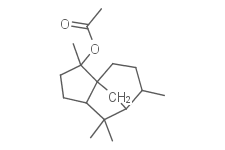
Cedryl acetate
CAS No. 77-54-3
Cedryl acetate( —— )
Catalog No. M19099 CAS No. 77-54-3
The fungal transformation of cedryl acetate was investigated for the first time by using Cunninghamella elegans.
Purity : >98% (HPLC)
 COA
COA
 Datasheet
Datasheet
 HNMR
HNMR
 HPLC
HPLC
 MSDS
MSDS
 Handing Instructions
Handing Instructions
| Size | Price / USD | Stock | Quantity |
| 100MG | 38 | Get Quote |


|
| 200MG | 52 | Get Quote |


|
| 500MG | Get Quote | Get Quote |


|
| 1G | Get Quote | Get Quote |


|
Biological Information
-
Product NameCedryl acetate
-
NoteResearch use only, not for human use.
-
Brief DescriptionThe fungal transformation of cedryl acetate was investigated for the first time by using Cunninghamella elegans.
-
DescriptionThe fungal transformation of cedryl acetate was investigated for the first time by using Cunninghamella elegans.
-
In Vitro——
-
In Vivo——
-
Synonyms——
-
PathwayCell Cycle/DNA Damage
-
TargetHDAC
-
RecptorOthers
-
Research Area——
-
Indication——
Chemical Information
-
CAS Number77-54-3
-
Formula Weight264.41
-
Molecular FormulaC17H28O2
-
Purity>98% (HPLC)
-
SolubilityIn Vitro:?DMSO : 50 mg/mL (189.11 mM)
-
SMILES[C@@]123[C@H](C([C@@H](C1)[C@](CC2)(C)OC(=O)C)(C)C)CC[C@H]3C
-
Chemical Name——
Shipping & Storage Information
-
Storage(-20℃)
-
ShippingWith Ice Pack
-
Stability≥ 2 years
Reference
1. Sultan S, et al. Eur J Med Chem. 2013 Apr;62:764-70.
molnova catalog



related products
-
M 344
M344 is a potent HDAC inhibitor with IC50 of 100 nM and able to induce cell differentiation.
-
Marbostat-100
Marbostat-100 is a potent, selective HDAC6 inhibitor with Ki of 0.7 nM.
-
BRD4354
BRD4354 is a moderately potent, selective, reversible inhibitor of HDAC5 and HDAC9 with IC50 of 0.85 uM and 1.88 uM.



 Cart
Cart
 sales@molnova.com
sales@molnova.com


